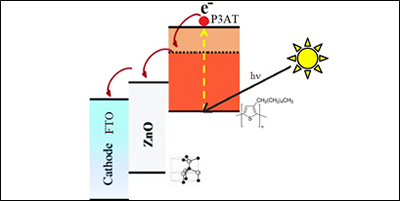
- Solar energy,
- Semiconductor,
- Polymer,
- Renewable energy
Copyright (c) 2021 Orbital: The Electronic Journal of Chemistry

This work is licensed under a Creative Commons Attribution-NonCommercial-NoDerivatives 4.0 International License.
Abstract
Poly(3-alkylthiophenes), P3AT, are organic polymers formed by conjugate structures with conductive properties. Zinc oxide (ZnO) has been used as an electron acceptor in hybrid solar cells because it offers electron transport properties and can be synthesized by methods in which the variation of synthesis parameters allows morphological control. Different ZnO morphologies allow for distinct properties in terms of electronic transport at the interface of solar cells. ZnO particles were synthesized by the co-precipitation method. ZnO films were deposited by spin-coating in Fluorine Tin Oxide (FTO) and then immersed in solutions containing poly (3-hexylthiophene) (P3HT) or poly (3-octylthiophene) (P3OT) polymers. The cell was assembled in the form of a sandwich consisting of: FTO/ZnO,P3AT/Iˉ,I3ˉ/Pt/FTO. UV-vis measurements were performed for bandgap calculation, scanning electron microscopy (SEM), X-ray diffraction (XRD), and J-V curves. The ZnO/P3HT cell presented the best values of J, V and η, indicating an improvement in the electronic transfer processes, with a value of η = 0.56%.
